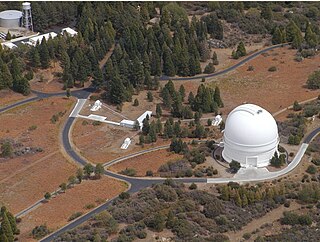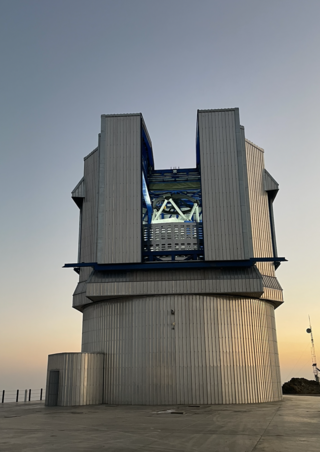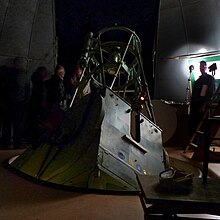
The Kitt Peak National Observatory (KPNO) is a United States astronomical observatory located on Kitt Peak of the Quinlan Mountains in the Arizona-Sonoran Desert on the Tohono Oʼodham Nation, 88 kilometers (55 mi) west-southwest of Tucson, Arizona. With more than twenty optical and two radio telescopes, it is one of the largest gatherings of astronomical instruments in the Earth's northern hemisphere.

Palomar Observatory is an astronomical research observatory in the Palomar Mountains of San Diego County, California, United States. It is owned and operated by the California Institute of Technology (Caltech). Research time at the observatory is granted to Caltech and its research partners, which include the Jet Propulsion Laboratory (JPL), Yale University, and the National Astronomical Observatories of China.

The David Dunlap Observatory (DDO) is an astronomical observatory site in Richmond Hill, Ontario, Canada. Established in 1935, it was owned and operated by the University of Toronto until 2008. It was then acquired by the city of Richmond Hill, which provides a combination of heritage preservation, unique recreation opportunities and a celebration of the astronomical history of the site. Its primary instrument is a 74-inch (1.88 m) reflector telescope, at one time the second-largest telescope in the world, and still the largest in Canada. Several other telescopes are also located at the site, which formerly also included a small radio telescope. The scientific legacy of the David Dunlap Observatory continues in the Dunlap Institute for Astronomy & Astrophysics, a research institute at the University of Toronto established in 2008.

In astronomy, the 2dF Galaxy Redshift Survey, 2dF or 2dFGRS is a redshift survey conducted by the Australian Astronomical Observatory (AAO) with the 3.9m Anglo-Australian Telescope between 1997 and 11 April 2002. The data from this survey were made public on 30 June 2003. The survey determined the large-scale structure in two large slices of the Universe to a depth of around 2.5 billion light years. It was the world's largest redshift survey between 1998 and 2003. Matthew Colless, Richard Ellis, Steve Maddox and John Peacock were in charge of the project. Team members Shaun Cole and John Peacock were awarded a share of the 2014 Shaw Prize in astronomy for results from the 2dFGRS.

The Center for Astrophysics | Harvard & Smithsonian (CfA), previously known as the Harvard–Smithsonian Center for Astrophysics, is an astrophysics research institute jointly operated by the Harvard College Observatory and Smithsonian Astrophysical Observatory. Founded in 1973 and headquartered in Cambridge, Massachusetts, United States, the CfA leads a broad program of research in astronomy, astrophysics, Earth and space sciences, as well as science education. The CfA either leads or participates in the development and operations of more than fifteen ground- and space-based astronomical research observatories across the electromagnetic spectrum, including the forthcoming Giant Magellan Telescope (GMT) and the Chandra X-ray Observatory, one of NASA's Great Observatories.
The University of Cambridge has three large astronomy departments as follows:

Frank Kelley Edmondson was an American astronomer.
Leuschner Observatory, originally called the Students' Observatory, is an observatory jointly operated by the University of California, Berkeley and San Francisco State University. The observatory was built in 1886 on the Berkeley campus. For many years, it was directed by Armin Otto Leuschner, for whom the observatory was renamed in 1951. In 1965, it was relocated to its present home in Lafayette, California, approximately 10 miles (16 km) east of the Berkeley campus. In 2012, the physics and astronomy department of San Francisco State University became a partner.

The Royal Observatory, Edinburgh (ROE) is an astronomical institution located on Blackford Hill in Edinburgh. The site is owned by the Science and Technology Facilities Council (STFC). The ROE comprises the UK Astronomy Technology Centre (UK ATC) of STFC, the Institute for Astronomy of the School of Physics and Astronomy of the University of Edinburgh, and the ROE Visitor Centre.

The Brera Observatory is an astronomical observatory in the Brera district of Milan, Italy. It was built in the historic Palazzo Brera in 1764 by the Jesuit astronomer Roger Boscovich. Following the suppression of the Jesuits by Clement XIV on 21 July 1773, the palace and the observatory passed to the then rulers of northern Italy, the Austrian Habsburg dynasty.

The Warner and Swasey Observatory is the astronomical observatory of Case Western Reserve University. Named after Worcester R. Warner and Ambrose Swasey, who built it at the beginning of the 20th century, it was initially located on Taylor Road in East Cleveland, Ohio, USA. The observatory, which at that time housed a 9.5-inch (24 cm) refractor, was donated in 1919 to the Case School of Applied Science. The newer 24-inch (61 cm) Burrell Schmidt telescope was built in 1939.

The Astronomical Observatory of Rome is one of twelve Astronomical Observatories in Italy. The main site of the Observatory is Monte Porzio Catone. Part of the Istituto Nazionale di Astrofisica since 2002.

The Dearborn Observatory is an astronomical observatory located on the Evanston campus of Northwestern University. The observatory was originally constructed in 1888, through an agreement between the university and the Chicago Astronomical Society. In the summer of 1939, Dearborn Observatory had to be moved to make way for the construction of the Technological Institute.

Leibniz Institute for Astrophysics Potsdam (AIP) is a German research institute. It is the successor of the Berlin Observatory founded in 1700 and of the Astrophysical Observatory Potsdam (AOP) founded in 1874. The latter was the world's first observatory to emphasize explicitly the research area of astrophysics. The AIP was founded in 1992, in a re-structuring following the German reunification.

Cambridge Observatory is an astronomical observatory at the University of Cambridge in the East of England. It was established in 1823 and is now part of the site of the Institute of Astronomy. The old Observatory building houses the Institute of Astronomy Library which has a collection of modern and historical astronomical books.

The Orchard Hill Observatory is an astronomical observatory located at the highest point on the University of Massachusetts Amherst campus. Constructed in 1965, the observatory is a red brick building with a 16-inch Cassegrain reflector optical telescope. It is used for several community events.
George Petros Efstathiou is a British astrophysicist who is Professor of Astrophysics (1909) at the University of Cambridge and was the first director of the Kavli Institute for Cosmology at the University of Cambridge from 2008 to 2016. He was previously Savilian Professor of Astronomy at the University of Oxford.

The Kavli Institute for Cosmology, Cambridge (KICC) is a research establishment set up through collaboration of the University of Cambridge and the Kavli Foundation. It is operated by two of the University's astronomy groups: the Institute of Astronomy (IoA) and the Cavendish Astrophysics Group.

Iranian National Observatory (INO) is an Iranian astronomical observatory inaugurated in 2021. It has reported the capture of its first light on 15 October 2022 upon the commissioning of INO340, a home-grown optical telescope with a primary mirror of 3.4 m, making it by far the country's largest astronomical research facility.
Tenagra Observatory and Tenagra Observatory II are astronomical observatories in Cottage Grove, Oregon and Arizona. The observatories house heavily automated robotic telescopes.





















